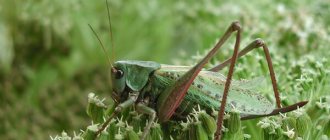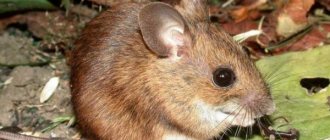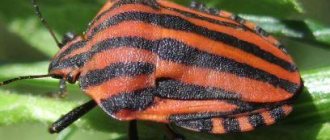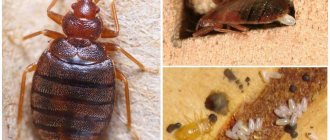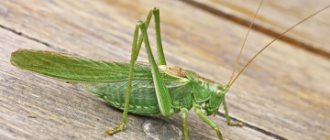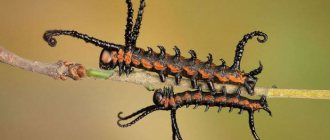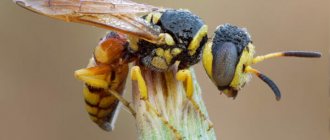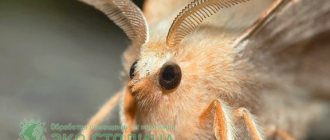There are a huge number of insects. The predator is a representative of the hemiptera family. Most of these representatives are predators. Insects are common on all continents. The bug can bite painfully. All insects of this species are able to camouflage themselves perfectly. There are 6,000 predators identified. About 100 subspecies live in the territory of the former USSR. They love trees and grass. This is where they spend most of their time. Representatives are most active at night. During the day they are sedentary.
A raptor is a predatory insect
The color is black or brown, less often – bright with rich inclusions. The latter live only in tropical countries. Color directly depends on the place of residence and environmental conditions.
The predator moves slowly. Wings are completely absent or underdeveloped. They are often located on the belly. The head is elongated and narrow. This is where the eyes are located. The proboscis is short and weak. The shape is awl-shaped.
Using the upper jaw, the representative pierces the skin, and the lower jaw drinks blood. The trunk is curved and resembles a beak. Females are very similar to males.
The female lays 20 eggs at one time. Development takes 2 months on average. The final formation ends only after 6 months. The representative hunts only at night. The attack on the victim occurs from an ambush. The insect waits for the right moment and attacks its victim.
Insect drinks blood
Where are they common and what are their behavioral characteristics?
The place of residence directly depends on the subspecies of the bug. Insects live everywhere except Antarctica. The most common representatives are in Europe, Africa and North America. They live both in the wild and near humans.
The predator is an active nocturnal predator. During the day, the insect hides in a shelter, and at night it goes in search of food. The representative is able to remain motionless for a long time. At the most opportune moment, the bug makes a sharp lunge.
The insect injects a drop of toxic substance into the body of the victim. This paralyzes the bitten individual. The bug often lives in abandoned buildings. Selects places with an abundance of sand and dirt. In warm regions it settles outdoors.
Representatives with wings fly well at night. Insects are attracted to bright light from lamps. They often fly into human habitation.
Ants and bedbugs
The No. 1 natural enemy of bed bugs is pharaoh ants. These are tiny red insects measuring 2-6 mm. who love to live in the same room with a person just like bedbugs. A colony of pharaoh ants can completely exterminate bed bugs, but this is not the best method of fighting bed bugs, since you will get a new “house” parasite that will bother you!
The poison, or rather the acid, secreted by pharaoh ants is fatal to bed bugs. A couple of tiny red ants can kill an adult!
What are the features of reproduction?
The predator becomes sexually mature at the age of 3-6 months, depending on the subspecies. In warm countries, reproduction can occur year-round. The peak occurs at the end of summer. The female lays 2 eggs daily.
They reproduce by laying eggs
The masonry is deposited in moist soil. The insect covers the eggs with lumps of dirt to hide the new offspring from the threat. The length of the eggs reaches 3 mm. The diameter does not exceed 2 mm. Only after 3 weeks do nymphs appear.
The body of young insects is red-brown. Only after molting the color turns black. Under unfavorable conditions, this can happen only in the 2nd year of life.
What are the symptoms of a bite
Contact with insects should be avoided. The main symptoms of a bite are presented in the table.
| General characteristics | The dirty predator and the ringed one bite the most painfully. The bite is more like a hornet attack. The reaction to a bite appears instantly. Symptoms persist for 2-3 months. Tropical representatives cause severe consequences. |
| Symptoms | The main symptoms of a bite include: • swelling; • feeling of severe itching; • pain and redness of the skin; • loss of consciousness; • dizziness; • increased heart rate. |
Immediately after the bite, the skin begins to swell and hurt. The lesion site increases in size. There is a high probability of developing an allergic process. Redness and itching do not go away for several months, which causes severe discomfort to the person.
After a bite, an allergic reaction in the form of Quincke's edema is possible
Quincke's edema rarely occurs. Allergies are usually not serious. For a long period of time after the bite, symptoms may be completely absent. Chagas disease develops.
If you ignore a bite, the consequences are sad, even if the damage was caused by a herbivorous representative. Severe pain does not disappear throughout the day. The area will take a long time to heal.
Appearance of garden bug pests
There are many varieties of stink bugs that parasitize cultivated plants. Certain populations harm fruit and berry plants from the moment they sprout from seeds. Other parasites have adapted to feed on the juices of wild vegetation. However, if there are areas planted with crops nearby, they instantly move to them.
- Green forest shield . In everyday life, the insect is known as the garden green bug. In the wild, it feeds on the sap of trees and shrubs that form forests. In addition, he is not averse to eating cultivated plants. First of all, parasitic individuals capture raspberries (hence another popular name - raspberry bug), and then spread throughout all the plants in the garden, causing damage to the crops.
- Cruciferous bug . This is a rather harmful representative of shield insects. Northern Eurydema (as entomologists call this most dangerous parasite) is very similar in appearance to the soldier bug. The parasite causes enormous damage to crops from the cruciferous family. Insect infestations lead to the complete death of plants.
- Pear bug . The insect amazes with the beauty of its “lace outfit,” causing the admiration of people who do not know about its true nature. It is insidious towards pears, apple trees, apricots, plums, cherries and other fruit trees. Hordes of parasites can destroy both fruits and trees.
- Berry shield . Parasites pose a danger to most fruit and berry plants. These bugs are found on currants, raspberries, gooseberries and other fruit-bearing bushes.
- Cucumber bug . The individuals are quite small - the body length is only 3 mm. But the damage caused to cucumbers, tomatoes, eggplants and peppers is great. The bottom of leaves is a favorite habitat for parasites. It is difficult to fight agile shield creatures. They jump long distances and instantly infect greenhouses regardless of size.
- The shield bug is a harmful turtle . The classic variety of this bug is not dangerous for homesteads. Their main food is cereals. They cause harm in gardens and orchards when there is a shortage of grains. Hungry bugs in garden plots eat everything.
- The horse fly bug is a tiny pest with an inconspicuous appearance. It parasitizes almost all garden crops. The horsefly bug is the scourge of farms.
- Ringed predator . The abode of this bug is apiaries. The pest hunts bees, lying in wait for them in the inflorescences of honey plants.
What complications
Bedbugs carry the causative agent Chagas disease. The microorganism enters the wound along with the waste products of the parasite. The incubation period of the disease is 7-12 days. Severe swelling and inflammation appears in the damaged area. The skin is hard to the touch.
Lymph nodes enlarge. The infection does not spread until 4-6 weeks. There is a feeling of malaise, headaches, muscle weakness. Body temperature increases. The fever does not go away within 2 weeks.
An increase in temperature is often observed
There is a small rash on the skin. The liver and spleen increase in size. Heart failure develops. The likelihood of death increases. The prognosis for recovery in advanced stages is minimal.
Death is also possible in the initial stages of the disease. Due to a number of complications, a person is forced to reduce his activity.
How to prevent a bite
To prevent bites, it is recommended:
- wear closed clothing outdoors;
- do not use soap before going outside;
- protect the skin with special creams and sprays against insects;
- do not walk barefoot on the grass;
- do not walk in overgrown areas;
- do not put your hands into holes or nests;
- do not get close to the parasite;
- Clean the house regularly and use mosquito nets on the windows;
- Call special services if bedbugs appear in the house.
All recommendations help reduce the likelihood of getting parasites.
It is not recommended to walk barefoot on the grass
Useful entomophages. Orius Levigatus
02/18/2019 Predatory bug Orius Levigatus ( lat. Orius laevigatus
) is a universal entomophage that destroys all mobile stages of development of insect pests. In particular, it is capable of eating spider mites, thrips larvae (western flower and tobacco), whiteflies, aphids, moth and cutworm embryos, and therefore is widely used in agriculture to combat these pests.
In the absence of food of animal origin, Orius Levigatus can consume pollen and plant sap as an alternative source of food, so it is often planted on nightshade crops (in particular pepper), since these plants produce abundant pollen. This approach allows the insect to form a stable population on crops even in the absence of hunting objects.
To protect plants, the predatory bug is used mainly to resist thrips (both adult insects and older larvae) in greenhouses and greenhouses, in open ground, as well as to combat these pests on fruit trees and shrubs. But most often the entomophage is used on crops such as garden strawberries, sweet peppers, melon, beans, alfalfa and corn.
The advantage of using this entomophage in comparison with other related species ( for example, the bugs Orius Majusculus and O. Niger
) is that this species does not enter diapause.
Description of the predatory bug
Orius Levigatus is widespread throughout the Mediterranean basin, from Western Europe to the Middle East.
The adult is a rather small insect (from 1.5 to 2.5 mm long), which can have either a light brown or dark brown color, while its body is completely covered with small gray spots.
The female individual differs from the males in having a more pointed end of the abdomen and the presence of an ovipositor.
An adult bug has a piercing-sucking mouthparts and is equipped with two pairs of wings, the front pair being partially hard.
Adults are very mobile and have good flight abilities, which helps insects quickly find their prey.
The sex ratio in the population is usually one to one.
During its life cycle, Orius Levigatus goes through seven stages of development:
· Embryo
Nymph (5 ages)
· Imago
The life cycle of a bedbug lasts from 20 to 45 days, and depends primarily on weather conditions and the availability of quality food. At the same time, the lifespan of males is slightly shorter than that of females.
Orius Levigatus has the ability to quickly increase its population, especially at air temperatures from +21° to +27°C and humidity above 60%.
During a season, the female is capable of laying from 120 to 150 embryos, which she places in the parenchyma on the lower part of the leaves, almost completely immersing the embryos in the plant tissue.
The eggs have a milky hue and size from 0.4 to 0.13 millimeters.
The larva is born glossy and colorless, but as it develops it acquires a yellowish tint, and by the second and third molting phases it becomes bright orange. Older larvae are brown and resemble adults in appearance.
All age stages of Orius are distinguished by their gluttony, and they destroy significantly more phytophages than the insects need to satiate.
Use of entomophages for plant protection
To prevent the reproduction of thrips Orius Levigatus, 0.5-1 individuals should be populated for each square meter of area with an interval of two weeks. It is advisable to do this in cool and windless weather (morning or evening) to limit the flight of bedbugs.
If there is a significant number of pests, entomophages should be launched at the rate of 10-12 insects per square meter of area. In this case, the efficiency of their use can reach 85% or higher.
Storage and transportation of biomaterial
When transporting bedbugs, the packaging should not be exposed to direct sunlight, and should be used for its intended purpose no later than two days after purchase.
Biomaterial is supplied, as a rule, in a container that contains 500 nymphs and adult insects.
What to do if you are bitten
The main thing is not to scratch the affected area. Otherwise, the likelihood of infection increases. Do not apply dirty rags or leaves to the affected area. Do not water the wound with water from bodies of water.
If bitten, it is recommended:
- wash the bite site with soap and water;
- apply a paste of salt to the skin, which is prepared by mixing salt and water in a ratio of 3:1;
- Take an allergy medication if you are prone to an individual reaction or its occurrence.
It is better to consult a doctor after suffering a pest bite.
You can learn more about the predator if you watch this video:
Shield bug or Italian bug
Italian bug - got its name because of the similar colors to the Vatican soldiers.
They do not encroach on human skin, but their diet includes umbrella cultivated plants, such as parsnips, parsley, carrots, dill and others, including various berries.
The larvae of these insects harm buds, flowers and seeds at all stages of their development.
At the same time, the damage caused to cultivated plants by the stink bug does not have serious economic consequences in the spring, but when their invasion occurs in the summer months, the crops suffer greatly.
